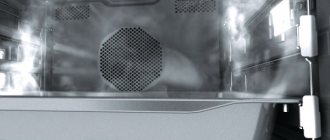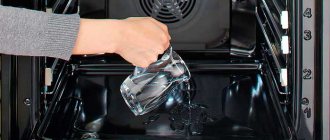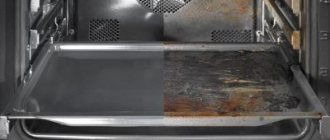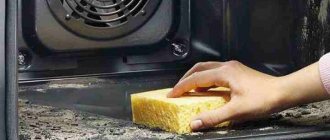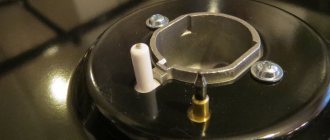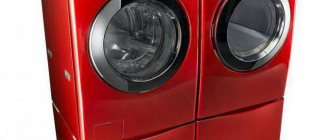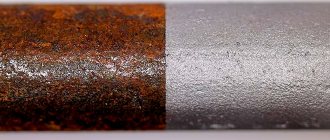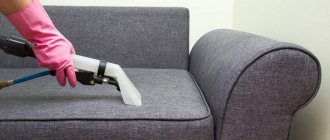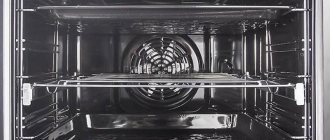Oven steam cleaning is a method of getting rid of grease and other contaminants inside the oven. For many women, cleaning the oven at home is an unpleasant procedure. Contaminants accumulate on the inner surface during the cooking process, so for those who cook frequently, this problem cannot be avoided. In order for your household appliance to last longer and maintain its ideal appearance, you need to clean it periodically.
Steam oven cleaning: what is it, pros and cons
Modern manufacturers present three main options for cleaning ovens: catalytic, hydrolysis and pyrolytic. All these methods are very different, each of them has its pros and cons. Hydrolysis cleaning, what is it really? This system is a cleansing of formed fat, which occurs under the influence of steam.
Oven steam cleaning, what is it? The answer to this question can be very simple - this is a hydrolysis method of purification. “Hydro” means water, but “lysis” means disintegration or decomposition.
Be sure to place a special baking tray in the heated oven and pour water into it; you can, if desired, add any detergent to it. At a low temperature, the fat that has settled on the surface breaks down and, as a result, flows into the pan. Then the baking sheet is simply washed. True, this method of cleansing should be carried out only after removing the dishes from the oven.
Advantages of this type:
- The easiest way to clean;
- The case does not get very hot;
- There is no need to resort to chemicals for help;
- Cheap way;
- Energy saving type.
Many ovens have an aquaclean function, which cleans the inside of the appliance with steam. Steam cleaning occurs at a temperature of 90 degrees. The water is converted into steam, which in turn dissolves the grease, which can then be removed with a wet cloth. This aqualytic hydrolysis cleaning system is used by one of the well-known companies Hansa. A special feature of this technology is a specially developed enamel, the chemical composition of which makes it possible to easily break down any contaminants under the influence of moisture or steam.
Useful tips
To make hydrolytic oven cleaning more effective, it is useful to consider several recommendations:
- In addition to dishwashing detergent, you can add other cleaning agents to the water poured into the pan: citric acid, vinegar, orange or lemon juice.
- Steam cleaning can be repeated to remove stubborn stains.
- Used water should not be left in a baking tray or special oven compartment overnight.
Modern oven system, what is it: catalytic cleaning or traditional
It is necessary to wash the oven after each cooking so that the resulting grease or dirt does not eat into the enamel of the oven. Traditional cleaning is done by hand, using a soft sponge and any non-aggressive cleaning product. However, it takes a lot of time and effort. This means choosing an oven with self-cleaning, for example, with a catalytic cleaning function.
Catalytic purification is a chemical process that occurs under the influence of a catalyst. The catalyst itself is located in the pores of a special enamel with which the oven walls are equipped.
Catalysis, as is known from chemistry lessons, can be called acceleration. Therefore, the catalyst in this purification system is an accelerator of the process. The oven walls are coated with special silvermatte enamel. Cleansing begins most quickly at a temperature of 200 - 250 degrees, that is, during the preparation of any dish. The oven heats up, and the fats begin to oxidize and break down.
Advantages of catalytic cleaning:
- Saves electricity;
- Requires only partial supervision;
- Used in both electric and gas appliances.
Has Catholic purification and some disadvantages. For example, the material from which the walls of the oven are made must be changed over time (once every 4-5 years), as it loses its original properties. The higher the quality of the material, the higher the cost of the oven itself. And one more thing - the enamel does not cover the entire area of the oven, but only its side walls, so the door and bottom will need to be cleaned manually.
Easy to clean enamel in Electrolux ovens with Aqua Clean function
Electrolux ovens with the Aqua Clean function have a special coating on their internal surfaces. As you know, during pyrolytic cleaning, the most important quality of enamel is the ability to withstand high temperatures without cracking, and catalytic panels have the ability to quickly break down fats. The enamel of ovens that are cleaned using hydrolysis has another advantage: the smooth surface prevents food particles and drops of fat from firmly attaching, so that after softening with steam, they can be removed with just one swipe of the sponge.
Effective pyrolytic cleaning: its advantages
The most effective type of cleaning is pyrolytic. This system is the newest and, accordingly, such devices cost quite a lot. This pyrolysis cleaning is based on the combustion of contaminants at high temperatures. Pyrolysis is a very complex thermal decomposition of various compounds. Pyrolytic means splitting.
Pyrolytic cleaning occurs at a very high temperature, which ranges from 250 to 500 degrees. At this temperature, all contaminants burn to form ash. This is a home crematorium.
If previous types of cleaning include partial manual assistance, then pyrolytic cleaning does everything itself, freeing the owner from additional cleaning. Since combustion occurs at very high temperatures, the oven door locks itself. Therefore, it can be opened only after the process is completed.
Oven cleaning: which one is better?
All types of oven cleaning are good in their own way. However, you need to choose the one that will meet all your requirements. If, for example, you do not use the oven often, then hydrolysis or catalytic cleaning is suitable for you. And if regularly, then only pyrolytic. But for those who want to save money, by the way, there will also be an oven with the traditional method.
Oven cleaning, which is better? Many people cannot decide for themselves which cleaning method to choose an oven with. Therefore, they doubt their choice for a long time. To do this, you just need to carefully weigh all the pros and cons of the device you choose.
Many people ask: advise the best model from many options. It is best to choose a device with catalytic cleaning. It is more economical and is also suitable for both electric and gas appliances.
All types of cleaning:
- Traditional;
- Catalytic;
- Hydrolytic;
- Pyrolytic.
You can also find ovens with a type of cleaning called ecolysis. This is one of the types of catalytic cleaning, however, it provides greater environmental friendliness. Manufacturers such as Bosch and Siemens produce just such ovens. The Ariston company produces only 7 types of ovens with catalytic cleaning and 8 with pyrolytic cleaning, all of them have a high price. Other models have traditional cleaning.
Modern technology: oven cleaning systems (video)
When choosing an oven, do not forget to pay attention to its cleaning type. Some types of models may not be suitable for you due to their low functionality and cleaning method. However, following the reviews, we can conclude that the model with catalytic purification is in greater demand than other systems (hydrolysis, traditional and pyrolytic).
Steam oven cleaning: what is it, pros and cons
Modern manufacturers present three main options for cleaning ovens: catalytic, hydrolysis and pyrolytic. All these methods are very different, each of them has its pros and cons. Hydrolysis cleaning, what is it really? This system is a cleansing of formed fat, which occurs under the influence of steam.
Oven steam cleaning, what is it? The answer to this question can be very simple - this is a hydrolysis method of purification. “Hydro” means water, but “lysis” means disintegration or decomposition.
Be sure to place a special baking tray in the heated oven and pour water into it; you can, if desired, add any detergent to it. At a low temperature, the fat that has settled on the surface breaks down and, as a result, flows into the pan. Then the baking sheet is simply washed. True, this method of cleansing should be carried out only after removing the dishes from the oven.
Advantages of this type:
- The easiest way to clean;
- The case does not get very hot;
- There is no need to resort to chemicals for help;
- Cheap way;
- Energy saving type.
Many ovens have an aquaclean function, which cleans the inside of the appliance with steam. Steam cleaning occurs at a temperature of 90 degrees. The water is converted into steam, which in turn dissolves the grease, which can then be removed with a wet cloth. This aqualytic hydrolysis cleaning system is used by one of the well-known companies Hansa. A special feature of this technology is a specially developed enamel, the chemical composition of which makes it possible to easily break down any contaminants under the influence of moisture or steam.
Description of the method
Steam cleaning is also called hydrolysis. This is a fairly simple method that involves quickly removing any fat from the inner walls of the oven without using synthetic components.
It will not be possible to achieve complete cleansing of contaminants, but steam cleaning will make cleaning easier at the next stage.
Hydrolysis involves the use of water. To implement this method, pour a small amount of water onto a baking sheet, adding a little detergent to it. After this, the container is placed in the household appliance and the door is closed. Set the temperature at 90-190 °C.
Water changes from liquid to gaseous state, in other words, steam is formed. It acts on fat deposits. Steam must be used at a stage when contaminants have not yet dried in the oven.
Modern oven system, what is it: catalytic cleaning or traditional
It is necessary to wash the oven after each cooking so that the resulting grease or dirt does not eat into the enamel of the oven. Traditional cleaning is done by hand, using a soft sponge and any non-aggressive cleaning product. However, it takes a lot of time and effort. This means choosing an oven with self-cleaning, for example, with a catalytic cleaning function.
Catalytic purification is a chemical process that occurs under the influence of a catalyst. The catalyst itself is located in the pores of a special enamel with which the oven walls are equipped.
Catalysis, as is known from chemistry lessons, can be called acceleration. Therefore, the catalyst in this purification system is an accelerator of the process. The oven walls are coated with special silvermatte enamel. Cleansing begins most quickly at a temperature of 200 - 250 degrees, that is, during the preparation of any dish. The oven heats up, and the fats begin to oxidize and break down.
Fast, economical, environmentally friendly
One of the advantages of Swedish Asko equipment is its wide functionality: even models in the mid-price segment can boast a wide range of operational capabilities. If you decide to purchase an electric oven with an enamel interior, the AquaClean function will ensure cleanliness and hygiene. Steam cleaning technology is effective in its simplicity:
Cleaning time and temperature do not change. When the AquaClean function is turned on, only the bottom heating element of the electric oven works, so this technology from Asko can be considered energy efficient. Environmental friendliness is also at its best: hydrolysis can be used even without detergents - simply to refresh work surfaces and get rid of minor dirt immediately after baking.
To eliminate stubborn and old stains or burnt food residues, you will have to use non-aggressive household chemicals (without hard scrapers and sponges). Make sure that any detergent residues are completely removed from surfaces.
Effective pyrolytic cleaning: its advantages
The most effective type of cleaning is pyrolytic. This system is the newest and, accordingly, such devices cost quite a lot. This pyrolysis cleaning is based on the combustion of contaminants at high temperatures. Pyrolysis is a very complex thermal decomposition of various compounds. Pyrolytic means splitting.
Pyrolytic cleaning occurs at a very high temperature, which ranges from 250 to 500 degrees. At this temperature, all contaminants burn to form ash. This is a home crematorium.
If previous types of cleaning include partial manual assistance, then pyrolytic cleaning does everything itself, freeing the owner from additional cleaning. Since combustion occurs at very high temperatures, the oven door locks itself. Therefore, it can be opened only after the process is completed.
Advantages of this cleaning system:
- The most effective method;
- Does not require additional manual work;
- Able to cope with the most complex and long-standing contaminants;
- Performs complete cleaning;
- Turns varying degrees of pollution into ash.
Such devices are made only from very durable and high-quality materials. This method is used only for electric ovens. A huge disadvantage of such ovens is that the outer walls have the ability to get very hot. Therefore, such devices are not quite safe. Great care is required to avoid getting burned. In addition, the wiring may not withstand it if it is weak. Of course, the reviews for such cleaning are the highest, since it is the most practical system.
Household chemicals
Household chemicals will help deal with heavy stains. Such products quickly and effectively remove carbon deposits, grease and soot. The chemical industry market offers a wide selection of products, which are available in the form of gels, powders, sprays and pastes. Amway and Frosch are especially popular. Effective kitchen cleaner "Shumanit". It helps fight fat, scale, soot and food residues. However, it has an extremely unpleasant odor and corrodes the skin of your hands, so you should take precautions when working with it.
Before using household chemicals, carefully read the instructions on the packaging and make sure that the product is suitable for a specific surface. Use it according to the instructions. Do not exceed the permissible quantity and recommended processing time. When working with household chemicals, be sure to use rubber gloves, a respirator, and open the windows. After cleaning, thoroughly wash all surfaces with clean water to prevent chemical residues from getting into your food.
You can get rid of the smell of chemicals in several ways presented below.
Oven cleaning: which one is better?
All types of oven cleaning are good in their own way. However, you need to choose the one that will meet all your requirements. If, for example, you do not use the oven often, then hydrolysis or catalytic cleaning is suitable for you. And if regularly, then only pyrolytic. But for those who want to save money, by the way, there will also be an oven with the traditional method.
Oven cleaning, which is better? Many people cannot decide for themselves which cleaning method to choose an oven with. Therefore, they doubt their choice for a long time. To do this, you just need to carefully weigh all the pros and cons of the device you choose.
Many people ask: advise the best model from many options. It is best to choose a device with catalytic cleaning. It is more economical and is also suitable for both electric and gas appliances.
All types of cleaning:
- Traditional;
- Catalytic;
- Hydrolytic;
- Pyrolytic.
You can also find ovens with a type of cleaning called ecolysis. This is one of the types of catalytic cleaning, however, it provides greater environmental friendliness. Manufacturers such as Bosch and Siemens produce just such ovens. The Ariston company produces only 7 types of ovens with catalytic cleaning and 8 with pyrolytic cleaning, all of them have a high price. Other models have traditional cleaning.
Modern technology: oven cleaning systems (video)
When choosing an oven, do not forget to pay attention to its cleaning type. Some types of models may not be suitable for you due to their low functionality and cleaning method. However, following the reviews, we can conclude that the model with catalytic purification is in greater demand than other systems (hydrolysis, traditional and pyrolytic).
Modern household appliances have options that eliminate many kitchen hassles. One of these is automatic oven cleaning.
.
This function eliminates the need to climb into the chamber and scrape off the fat that has frozen on the walls. Automatic cleaning
not only saves you from a time-consuming and unpleasant process, but also helps you properly maintain the device. Thanks to her, the equipment lasts a long time.
Three solutions
After cooking, grease sticks to the walls and bottom of the oven, which turns into a thick crust when used for a long time without cleaning. If you begin to remove such a crust, you will need detergents, time and patience. It will take seven sweats until you can achieve cleanliness.
In many modern devices, this problem is solved using the automatic oven cleaning
. There are three solutions: pyrolysis, catalysis and hydrolysis. Each of them has advantages and disadvantages.
Catalysis: cleaning while cooking
The best way to keep something clean is to keep it from getting dirty. Catalytic panels installed inside the oven help you follow this unwritten law. The rough, finely porous coating on the panels promotes rapid oxidation of fat and accelerates the breakdown into its components: water and carbon.
Cleaning the oven
occurs when heated from 150°C and above, that is, the process will occur every time you cook at the specified temperature. There is no need to turn on a special mode, which allows you to save on electricity.
In catalytic ovens
Hansa uses double-sided plates. This solution allows you to double the service life of the panels.
Pyrolysis: heating to 500°C
Pyrolysis is a process that involves the thermal decomposition of leftover food. This is an aggressive and effective procedure that takes about two hours. The environment heats up to 500°C, and food particles turn into ash. For the safety of the owners, the door is locked during processing.
The pyrolytic coating applied to the inner walls helps to withstand high temperatures.
enamel. These models are the most expensive on the market.
The entire interior surface is cleaned, including the cabinet door. All you need to do is walk with a damp cloth after pyrolysis. During the procedure, the baking sheet can be left inside. Ovens with Pyrolytic cleaning
They are also equipped with a cooling system - a fan turned on after the procedure removes vapors and unpleasant odors from the chamber.
Pyrolysis consumes a lot of electricity. An oven with this fat-killing mode will require a power cable that can withstand high power.
Hydrolysis: steam treatment
Steam (or hydrolysis) mode allows you to quickly and effectively remove grease and other contaminants. It works as follows: half a liter of water is poured onto a baking sheet, and the temperature is set from 90 to 100°C. Within 30 minutes, leftover food softens under the influence of hot steam.
Some oven models have a hydrolysis cleaning program. The button to enable the function can be found on the control panel. Manufacturers mark it in different ways, so it’s worth looking at the instructions and finding the right icon. If your oven does not have a hydrolysis program, you can carry out the procedure yourself by setting the recommended temperature and turning on the heating from below.
After cleaning, dirt can be easily removed using a soft cloth and without the use of special products. However, steam cleaning
does not help in removing long-frozen layers of fat.
Such systems are also called Aqualytic
.
Many models on the domestic market are equipped with them. The hydrolysis method is more economical compared to other modes: electricity consumption and the price of ovens
are not as high as in the case of pyrolysis or catalysis.
Ammonia
Ammonia will help remove old fat from the surface of the oven. This product is quite effective, but has one significant drawback - an unpleasant odor. Generously moisten all surfaces of the oven with ammonia and leave overnight. In the morning, wash the device with plenty of water and a clean sponge.
To avoid rubbing surfaces with alcohol, use a simpler method. Pour ammonia into one container and boiling water into the other. Place a bowl of hot water on the bottom of the oven and a bowl of ammonia on the top shelf. Close the door and leave for several hours. Rinse off stains with water and a little dishwashing detergent.
When working with ammonia, be sure to use rubber gloves and a gauze bandage. After completing the procedure, leave the device open for ventilation.
Advantages and disadvantages
If you don’t want to clean the door manually, buy an oven with pyrolysis - this is the most effective method of getting rid of fat. However, it is also the most expensive.
Catalysis will be less expensive. Such a system does not require user supervision, but it does require additional care: you will have to wash the door and bottom of the oven yourself.
Steam mode is the most inexpensive. It operates at a relatively low temperature. In this case, you can achieve a good result if you use the method immediately after preparation. The main thing is not to let the fat dry out, then the steam will soften the dirt, and you can easily remove it with a cloth.
Level of purchase costs and energy consumption
